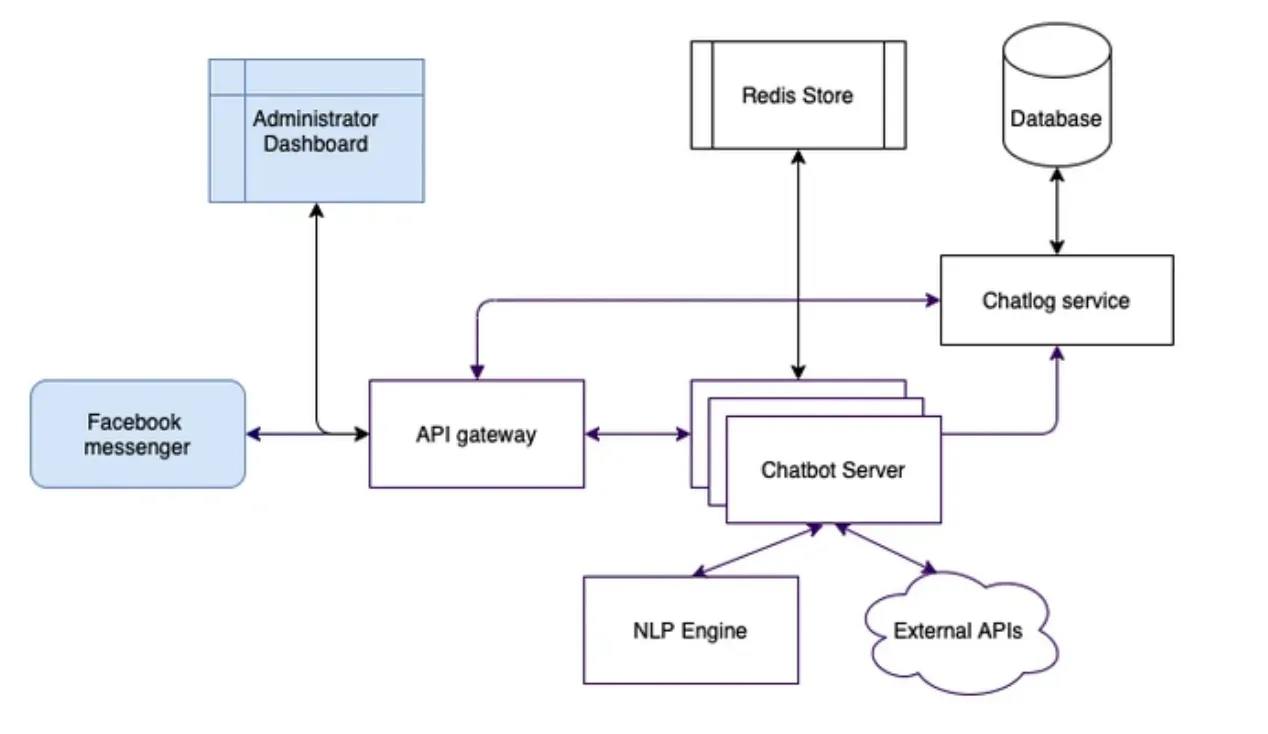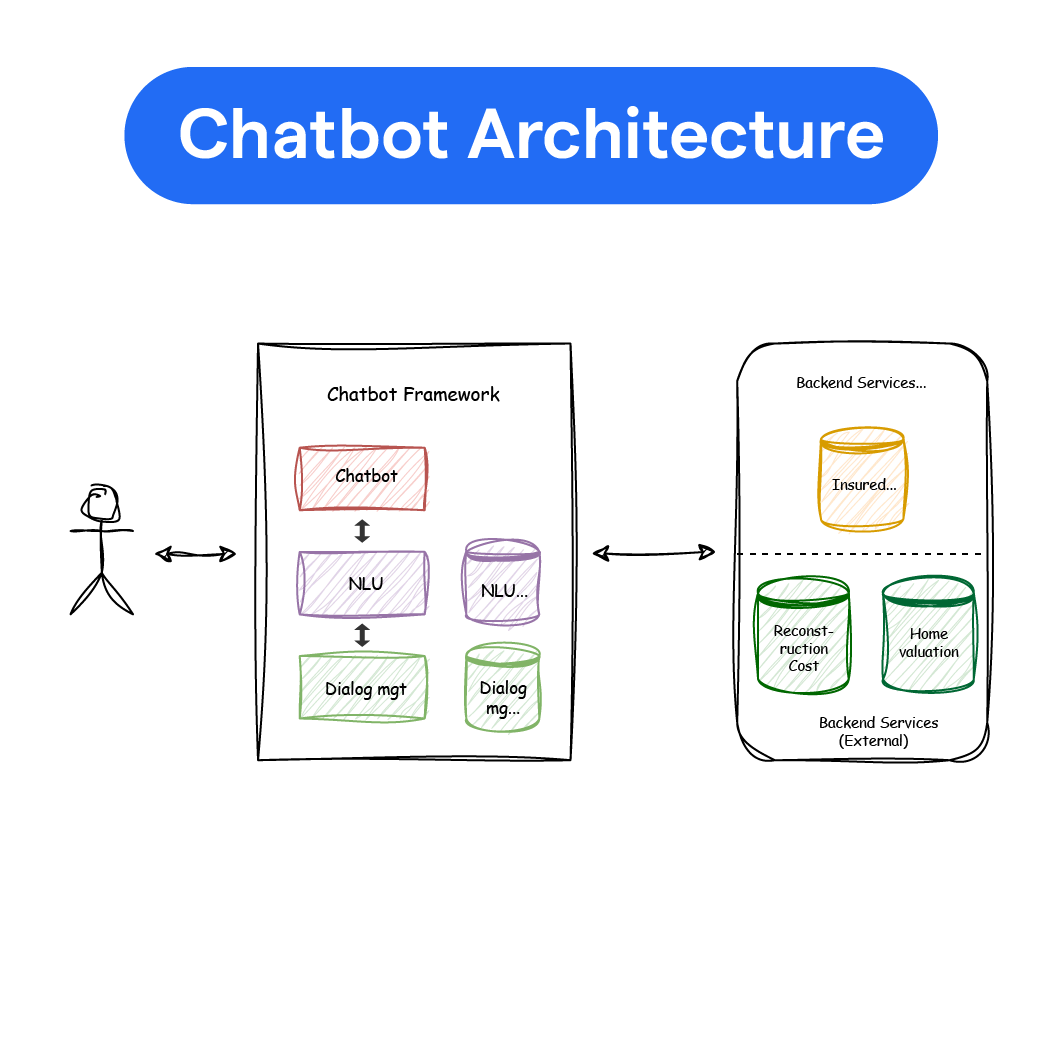What is Chatbot Architecture?
Chatbot is a computer program that leverages artificial intelligence (AI) and natural language processing (NLP) to communicate with users in a natural, human-like manner.
Chatbot architecture refers to the system the chatbot is built on. It involves the combination of database systems, AI, machine learning models, and NLP engines that enable a chatbot to understand and respond to user inputs.
Types of Chatbots
Chatbots are primarily classified into Rule-Based and AI-Based. Rule-based chatbots function based on predefined rules. AI-based chatbots, on the other hand, learn from conversations and improve over time.
Chatbot Interaction
Chatbots can communicate through either text or voice-based interactions. Text-based bots are common on websites, social media, and chat platforms, while voice-based bots are typically integrated into smart devices.
Why is Chatbot Architecture Important?
We'll now explore the significance of understanding chatbot architecture.
Enhances User Experience
Chatbot architecture is crucial in designing a chatbot that can communicate effectively, improve customer service, and enhance user experience.
It's an Industry Trend
With the continuous advancement of AI, chatbots have become an important part of business strategy development. Understanding chatbot architecture can help businesses stay on top of technology trends and gain a competitive edge.
Cost-Efficient
Having a well-defined chatbot architecture can reduce development time and resources, leading to cost savings.
Scalability and Flexibility
A well-designed chatbot architecture allows for scalability and flexibility. Businesses can easily integrate the chatbot with other services or additions needed over time.
Who builds Chatbot Architecture?
Let's demystify the agents responsible for designing and implementing chatbot architecture.
Chatbot Developers

Chatbot developers build the core architecture of chatbots. They usually have extensive experience in AI, ML, NLP, programming languages, and data analytics.
Data Scientists
Data scientists play a vital role in refining the AI and ML component of the chatbot. They analyze and interpret data patterns to train the chatbot further.
UX/UI Designers
User experience (UX) and user interface (UI) designers are responsible for designing an intuitive and engaging chat interface.
Project Manager
A project manager oversees the entire chatbot creation process, ensuring each constituent expert adheres to the project timeline and objectives.
When is Chatbot Architecture used?
Let's understand the scenarios where chatbot architecture is utilized.
Customer Service
Many businesses utilize chatbots in customer service to handle common queries instantly and relieve their human staff for more complex issues.
Product Recommendations
E-commerce companies often use chatbots to recommend products to customers based on their past purchases or browsing history.
Reservation and booking
Companies in the hospitality and travel industry use chatbots for taking reservations or bookings, providing a seamless user experience.
Surveys and Feedback
Chatbots are used to collect user feedback in a conversational and engaging way to increase response rates.
Where is Chatbot Architecture Used?
Here, we'll explore the different platforms where chatbot architecture can be integrated.
Websites
Many businesses utilize chatbots on their websites to enhance customer interaction and engagement.
Social Media Platforms
Chatbots are frequently used on social media platforms like Facebook, WhatsApp, and others to provide instant customer service and marketing.
Messaging Applications
Messaging applications such as Slack and Microsoft Teams also use chatbots for various functionalities, including scheduling meetings or reminders.
Mobile Applications
With the proliferation of smartphones, many mobile apps leverage chatbot technology to improve the user experience.
How is Chatbot Architecture Built?
Let's delve into the steps involved in building a chatbot architecture.
Define the Chatbot's Purpose
The first step is to define the chatbot's purpose, determining its primary functions, and desired outcome.
Decide the Type of Chatbot
Based on the bot's purpose, choose between a rule-based or AI-based chatbot.
Design Conversation Flow
Next, design conversation flows that define how the chatbot will interact with users.
Implement AI and ML Models
Leverage AI and machine learning models for data analysis and language understanding and to train the bot.
Integrating Bot into Platforms
After the bot is built, integrate it into the desired platform - whether it's a website, social media, messaging apps, or a mobile application.
Continuous Learning and Improvement
Post-deployment ensures continuous learning and performance improvement based on the insights gathered from user interactions with the bot.
Best Practices For Chatbot Architecture
Just like any piece of technology, a chatbot must have a clearly defined purpose. Whether it's for customer service, sales support, or gathering user feedback, define what the chatbot is designed to achieve.

Design an Intuitive User Interface
The user interface must be easy-to-understand and user-friendly. An intuitive design can significantly enhance the conversational experience, making users more likely to return and engage with the chatbot repeatedly.
Implement Natural Language Processing (NLP)
With NLP, chatbots can understand and interpret the context and nuances of human language. This technology allows the bot to identify and understand user inputs, helping it provide a more fluid and relatable conversation.
Ensure Adequate Training of the Chatbot
Machine learning plays a crucial role in training chatbots, especially those based on AI. It's important to train the chatbot with various data patterns to ensure it can handle different types of user inquiries and interactions effectively.
Personalize User Experience
Personalization can greatly enhance a user's interaction with the chatbot. Conduct user profiling and behavior analysis to personalize conversations and recommendations, making the overall customer experience more engaging and satisfying.
Ensure Scalability
As your business grows, so too will the number of conversations your chatbot has to handle. A scalable chatbot architecture ensures that, as demand increases, the chatbot can continue performing at an optimal pace.
Monitor and Iterate Continuously
Keep track of chatbot performance and user feedback. Continuously refine and update your chatbot based on this gathered data and insight. Just like any product or service, a chatbot is never truly "finished".
Constant testing, feedback, and iteration are key to maintaining and improving your chatbot's functions and user satisfaction.
Frequently Asked Questions (FAQs)
How much does it cost to build a chatbot?
Chatbot development costs depend on various factors, including the complexity of the chatbot, the platform on which it is built, and the resources involved in its creation and maintenance.
Do I need technical skills to build a chatbot?
Though it's possible to create a simple rule-based chatbot using various bot-building platforms, developing complex, AI-based chatbots requires solid technical skill in programming, AI, ML, and NLP.
What language is best for building a chatbot?
Python is widely favored for chatbot development due to its simplicity and the extensive selection of AI, ML, and NLP libraries it offers.
How can a chatbot understand user inputs?
Chatbots utilize NLP and AI to understand user inputs. These technologies enable bots to understand and analyze human language and respond in a manner that mirrors human conversation.
Can Chatbots replace human customer service representatives?
Chatbots can handle many routine customer queries effectively, but they still lack the cognitive ability to understand complex human emotions. Hence, while they can assist and reduce the workload for human representatives, they cannot fully replace them.

